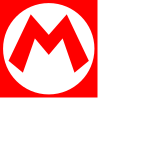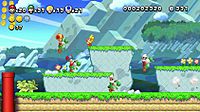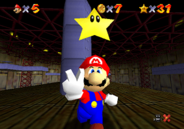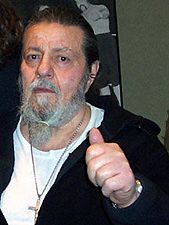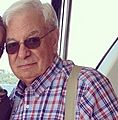Mario facts for kids
Quick facts for kids Mario |
|
|---|---|
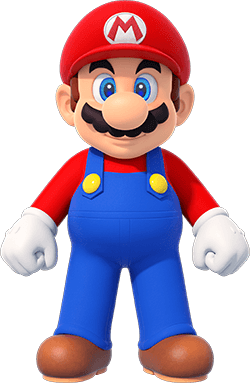
Mario, as depicted in New Super Mario Bros. U Deluxe
|
|
| First game | Donkey Kong (1981) |
| Created by | Shigeru Miyamoto |
| Designed by |
|
| Portrayed by |
|
| Voiced by | Charles Martinet (1991–2023) Kevin Afghani (2023–present) Others:
Larry Moran (Donkey Kong Cereal commercials)
Pat McBride (Donkey Kong Goes Home LP (1983)) Peter Cullen (Saturday Supercade) Tōru Furuya (1986–1998; Japanese) Hiroshi Otake (1986; Japanese) Gerri Sorrells (Super Mario: ABC no Utau Video) Lou Albano (The Super Mario Bros. Super Show!) Henry Corden (Mario Ice Capades) Nozomu Sasaki (1990; Japanese) Walker Boone (The Adventures of Super Mario Bros. 3, Super Mario World) Ronald B. Ruben (Mario Teaches Typing (MS-DOS)) Takeshi Aono (1992–1993; Japanese) Stevie Coyle (1992, 1997–1998; Mario in Real-Time, E3 puppet) Nicholas Glaeser (Mario Is Missing!) Tony Pope (Super Mario Bros. Audio Poster Pack) Kōsei Tomita (1993–1994; Japanese) Colin Case (Super Mario Compact Disco) Marc Graue (Hotel Mario) David Plaschon (Mario's Time Machine Deluxe) Dale Johannes (1996; E3 puppet) Seth Green (2014; Nintendo Digital Event segments) Chris Pratt (2023 film) Mamoru Miyano (2023 film; Japanese) |
| Information | |
| Nationality | Italian (games) Italian-American (other media) |
Mario is a famous character created by Japanese video game designer Shigeru Miyamoto. He is the main hero of the Mario game series. Mario is also the official mascot for the Japanese video game company Nintendo.
Mario is an Italian plumber. He lives in the Mushroom Kingdom with his younger twin brother, Luigi. Their adventures usually involve saving Princess Peach from the bad guy Bowser. They use special power-ups that give them cool abilities.
Mario first appeared in the game Donkey Kong in 1981. This was a platform game where he was the character you played. Miyamoto wanted to use the character Popeye, but he couldn't get the rights. So, he created Mario instead. Mario's look, like his big nose and mustache, was due to the limits of early arcade game graphics.
Miyamoto thought Mario would only be a small character. He was first called "Mr. Video" and "Jumpman." Later, he was named Mario after Nintendo of America's landlord, Mario Segale. After Donkey Kong, Mario starred in Mario Bros. (1983). Then, in 1985, Super Mario Bros. came out for the Nintendo Entertainment System. This game started the very successful Super Mario series.
Charles Martinet was Mario's voice from 1991 to 2023. Now, Kevin Afghani voices him. After Super Mario Bros., Mario started appearing in many different types of games. He has been in over 200 video games. These include puzzle games like Dr. Mario. He also stars in role-playing games like Paper Mario and Mario & Luigi. Plus, he's in sports games like Mario Kart and Mario Tennis.
Mario also appears in other Nintendo games, like the Super Smash Bros. series. This is a crossover fighting game where characters from different games fight. Mario has also been in cartoons. These include three series by DIC Entertainment. Lou Albano and Walker Boone voiced him in these shows. Bob Hoskins played Mario in the live-action Super Mario Bros. movie in 1993. More recently, Chris Pratt voiced him in The Super Mario Bros. Movie in 2023.
Mario is a huge pop culture icon. Many people consider him the most famous video game character ever. You can find him on lots of merchandise, like clothes and toys. People and places have even been named after him. He has also inspired a lot of fan-made content. The Mario game series has sold over 800 million copies worldwide. This makes it the best-selling video game franchise of all time.
How Mario Was Created
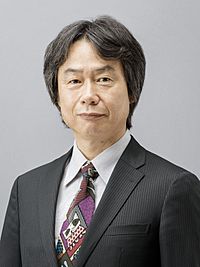
Shigeru Miyamoto created Mario while making the game Donkey Kong. Nintendo wanted a best-selling video game. Their earlier games, like Sheriff, hadn't been as popular as games like Pac-Man. Miyamoto first wanted to make a game using characters from the 1930s cartoon Popeye. But he couldn't get the rights to use them. So, he created a new, unnamed hero, along with Donkey Kong and Lady (who later became Pauline).
In the early stages of Donkey Kong, the game was about escaping a maze. Mario couldn't even jump at first. But Miyamoto soon added jumping. He thought, "If a barrel was rolling towards you, what would you do?" The game was set in New York City, inspired by the movie King Kong.
Mario's Name Story
The hero in the Japanese Donkey Kong game didn't have a name. But in the English instructions, he was called "Jumpman." In a sales brochure, he was called "little Mario." Miyamoto imagined a character that could appear in many of his games. He wanted a "go-to" character for small appearances. He didn't expect the character to become super popular on his own.
Miyamoto first named him "Mr. Video." He thought of it like how director Alfred Hitchcock made small appearances in his own movies. Looking back, Miyamoto said if he had kept the name "Mr. Video," Mario probably would have "disappeared."

There's a famous story about how Mario got his name. When Donkey Kong was being released in America, Nintendo of America's landlord, Mario Segale, demanded unpaid rent. After a big argument, Nintendo employees convinced Segale he would be paid. They then decided to name the character in the game "Mario" after him.
For a while, people wondered if Mario's full name was "Mario Mario." This idea came from the 1993 live-action movie. In 2012, Mario's voice actor, Charles Martinet, said his name was "Mario Mario." But Nintendo CEO Satoru Iwata disagreed, saying Mario had no last name. Miyamoto agreed at first. However, in 2015, Miyamoto changed his mind. He confirmed at a 30th Anniversary festival that Mario's full name is indeed "Mario Mario."
Mario's Look and Job

Miyamoto chose Mario's job to fit the game. In Donkey Kong, which takes place on a construction site, Mario was a carpenter. When he appeared in Mario Bros., he became a plumber. This was because much of that game happens underground. Mario's design, especially his big nose, was inspired by Western cartoons. After he became a plumber, Miyamoto decided to make him Italian and place him in New York City. He jokingly said Mario's mustache made him Italian.
Early arcade games had limited graphics. So, Miyamoto dressed Mario in red overalls and a blue shirt. These colors stood out against each other and the background. This made his arm movements easy to see. A red cap was added so Miyamoto didn't have to draw his hair or eyebrows. It also avoided animating his hair when he jumped. To give him human features with few pixels, Miyamoto drew a large nose and a mustache. This meant he didn't need to draw a mouth or facial expressions.
Over time, Mario's look became clearer. He gained blue eyes, white gloves, and brown shoes. His hat got a red "M" in a white circle. His overalls got gold buttons. The colors of his shirt and overalls also switched. He went from a blue shirt with red overalls to a red shirt with blue overalls. Miyamoto said these changes happened because of different game teams and better technology.
Mario's Voice
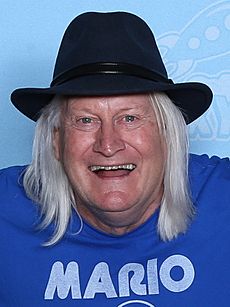
Charles Martinet was Mario's voice from 1991 to 2023. He got the role by chance. He arrived at the audition as they were closing. He was told to voice "an Italian plumber from Brooklyn." He first thought of a tough, mobster-like voice. But he decided that would be too harsh for kids. So, he tried a softer, friendly voice instead.
Martinet kept talking in this voice until the audition tape ran out. This was the only tape sent to Nintendo. The director called Nintendo and said he "found our Mario." For years, Martinet used this voice for a special attraction at trade shows. He would voice a 3D Mario head on a screen, hidden behind a curtain. People could talk to Mario, and he would respond. This was very popular for five years. Then, Miyamoto asked him to use the voice for a video game.
His first official game voice role was in Mario Teaches Typing in 1994. But his first big role was in Super Mario 64. Martinet loved the fun tone of the game. He has also voiced other Mario characters, like Luigi, Wario, and Waluigi. He records many sound clips for each game. Sometimes he records for three years before a game comes out, or just one week.
Martinet was recognized by Guinness World Records. He held the record for voicing the same character in the most roles (100 at the time). As of 2022, he voiced Mario in over 150 games. He recorded 5 million audio files with the voice. In August 2023, Nintendo announced Martinet would retire from voicing Mario. He will now be a "Mario Ambassador." Kevin Afghani took over the voice role in Super Mario Bros. Wonder.
Mario's Character Traits
Mario is shown as a slightly chubby plumber. He lives in the fictional Mushroom Kingdom with Luigi, his younger, taller brother. The first Mario Bros. game showed Mario and Luigi as Italians from New York. Cartoons and movies later said they were from Brooklyn. Mario's baby years, when a stork brought him to the Mushroom Kingdom, were first shown in Super Mario World 2: Yoshi's Island. In 2005, Miyamoto said Mario was about 24–25 years old. Nintendo Power magazine stated his birthday is October 11.
Mario wears a red long-sleeved shirt and blue overalls with yellow buttons. He also has brown shoes, white gloves, and a red cap with a red "M" on a white circle. In Donkey Kong, he wore red overalls and a blue shirt. In Super Mario Bros., he had a brown shirt and red overalls. He has blue eyes, brown hair, and a dark brown or black mustache. These color differences were due to early game design limits.
Mario's Jobs and Hobbies
Mario's main job is plumbing. But in the original Donkey Kong games, he was a carpenter. Mario has also had other jobs. In the Dr. Mario puzzle game series, he is a doctor named "Dr. Mario." In the Game Boy game Mario's Picross, he is an archaeologist. In Mario vs. Donkey Kong 2: March of the Minis, Mario runs a toy-making company.
Mario is also a great athlete in Mario sports games. He plays tennis and golf. He's also a kart racer in the Mario Kart series. In 2017, Nintendo said Mario was no longer considered a plumber. But they changed that statement in 2018.
Mario's Friends and Family
Mario usually saves Princess Peach and the Mushroom Kingdom. He also defeats bad guys like Bowser. Since his first game, Mario often saves a damsel in distress. At first, he had to rescue his girlfriend Pauline in Donkey Kong from Donkey Kong. Pauline was later replaced by Princess Peach in Super Mario Bros.. Pauline has since returned in the Mario vs. Donkey Kong series as Mario's friend. Mario usually saves Peach in the Super Mario series. But Peach rescued Mario in Super Princess Peach. Mario also saved Princess Daisy in Super Mario Land. However, Luigi is now more often linked to Daisy.
Luigi is Mario's brother. He is a helper in the Mario games. The second player controls Luigi in many two-player games. Luigi has also saved Mario sometimes, like in Mario Is Missing! and the Luigi's Mansion series. In Super Mario Land 2: 6 Golden Coins, Wario appeared. Wario is Mario's greedy rival. He is often a main bad guy or an antihero. The dinosaur character Yoshi is Mario's loyal friend and ride in games like Super Mario World.
Mario's Special Powers
During the making of Donkey Kong, Mario was called Jumpman (ジャンプマン, Janpuman). Jumping is a key part of Mario games, especially the Super Mario series. Mario jumps to reach places and to attack enemies. By the time Super Mario RPG came out, jumping was so much Mario's thing that players often had to jump to prove they were Mario.
Mario's most common attack is jumping on enemies' heads. He first used this in Super Mario Bros.. This jump-stomp can crush small enemies. It usually hurts bigger ones and can cause other effects. This attack often lets Mario knock turtle-like Koopa Troopas out of their shells. These shells can then be used as weapons. Later games added more jumping moves. Super Mario World added the spin-jump, which lets Mario break blocks below him. The Game Boy version of Donkey Kong lets Mario jump higher with repeated jumps and do a back-flip. In Super Mario 64, Mario learned new jumps like a sideways somersault. He also gained the ground pound, a powerful downward smash. The "Wall Kick" lets him jump higher by kicking off walls.
Power-Ups and Transformations
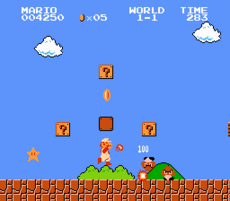
Mario uses special items called power-ups. These give him different abilities in different games. The first power-up Mario used was the Hammer in Donkey Kong.
Super Mario Bros. introduced three main power-ups that are still used today. These are especially common in the 2D games.
- The Super Mushroom is a large red mushroom. It makes Mario grow bigger and lets him survive one hit.
- The Fire Flower lets Mario throw fireballs.
- The Starman (later Super Star) makes Mario temporarily invincible.
These powers appear often throughout the series. There are also other Mushroom power-ups:
- The 1-up Mushroom (green) gives Mario an extra life.
- The Poison Mushroom (purple) makes Mario take damage.
- The Mega Mushroom (yellow and red) makes Mario huge and invincible for a short time.
- The Mini Mushroom (blue) makes Mario shrink. In some games, it lets him climb walls.
A common power-up lets Mario fly. The first one was in Super Mario Bros. 3. The Super Leaf gives Mario a raccoon tail and ears. It lets him swing his tail to attack, float gently, and fly for a short time. Another version in the same game is the Raccoon Suit (or Tanooki Suit). It gives the same abilities as the Super Leaf. It also lets Mario turn into a statue for a short time, making him invincible. There's also a P-Wing that looks like a Super Leaf but gives unlimited flight.
In Super Mario World, the Cape Feather gives Mario a cape. He can fly, spin, and swing his cape to attack. In Super Mario Land 2: 6 Golden Coins, a carrot gives Mario rabbit ears. These let him glide. In Super Mario 64, the Wing Cap lets him fly temporarily. Super Mario Sunshine introduces F.L.U.D.D., a water-spraying device. It lets Mario spray water and hover.
Mario 64 also had two other caps. One turns Mario into metal, making him immune to damage and able to walk underwater. The other makes him invisible and lets him pass through certain walls. These cap effects can be combined.
Super Mario Galaxy brought new power-ups:
- The Bee Mushroom (yellow and brown stripes) turns Mario into a bee. He can fly for a short time.
- The Boo Mushroom (ghostly white) turns Mario into a Boo. He can float and go through some walls.
- The Spring Mushroom (metallic) puts Mario in a spring. He can jump much higher.
- The Ice Flower lets the player walk or skate on water and lava without sinking.
Super Mario Galaxy 2 added more power-ups:
- The Cloud Flower lets Mario create platforms in midair.
- Rock Mario turns Mario into a boulder. He can use it to break through barriers.
New Super Mario Bros. Wii updated the Ice Flower. It lets Mario shoot ice balls that freeze enemies. It also introduced the Propeller Mushroom (orange with a propeller), which lets him fly. The Penguin Suit lets Mario move easily on ice and swim well. It also lets him shoot ice balls.
Super Mario 3D Land introduced the Boomerang Flower. It lets Mario throw boomerangs at enemies. The Statue Leaf lets Mario turn into a statue. In New Super Mario Bros. U, the Super Acorn makes Mario a flying squirrel. He can glide and stick to walls. Super Mario 3D World introduced the Super Bell, which turns Mario into a cat. It also has a Double Cherry to make multiple copies of himself.
Mario's Game Appearances
Mario is the main character of the Super Mario series. Each game has a different story. But most of them involve Mario saving Princess Peach from Bowser. Mario explores many different places called "worlds." He collects items and defeats enemies along the way. Most levels have a goal, like stars or flagpoles, that he needs to reach. Fans divide the series into two main types: the 2D side-scrolling Super Mario games and the 3D Super Mario games.
2D Super Mario Games
The Super Mario series started with platform games. The first was Super Mario Bros. on the Nintendo Entertainment System (NES) in 1985. In these games, Mario moves from left to right through levels. The screen scrolls as he moves. Mario's goal is to reach the end of the level, usually marked by a flagpole. These games focus more on jumping and moving than on a deep story. Bowser usually kidnaps Peach, and Mario, with Luigi's help, sets out to save her. Most worlds have small boss battles. These often involve fighting Bowser Jr. or one of the Koopalings. The final level is a big fight against Bowser.

Super Mario Bros. (1985) was Mario's first 2D game. The character started as a simple rectangle. Takashi Tezuka suggested the character be Mario after his success in Mario Bros.. Some ideas were cut, like Mario flying in a rocket. Developers planned for a small Mario who would grow bigger. They found it fun to make his size change with power-ups. This idea was inspired by Japanese folktales.
Super Mario Bros. 2 was not originally a Mario game. It was a game called Doki Doki Panic. After some problems, its development stopped. Later, it was changed to a Mario game for its international release. Most of the original gameplay stayed. The four main characters from Doki Doki Panic were re-skinned. Since they had different heights, this was the first time Mario was clearly shorter than Luigi.
Super Mario Bros. 3 experimented with Mario's look using different power-ups. For example, the raccoon tail was chosen over a centaur power-up. Levels were designed after power-ups were chosen, to use Mario's new abilities. The raccoon tail became a classic Mario power-up. It even appeared in games outside the Super Mario series, like Mario Kart 7. The game's success led to a cartoon show, The Adventures of Super Mario Bros. 3. Walker Boone voiced Mario in this show.
Hiroshi Yamauchi wanted a big game for the Game Boy that featured Mario. He believed "fun games sold consoles." Super Mario Land was designed without Miyamoto's help. This was a first for the series. The game used different elements for the Game Boy's small screen. For example, Mario saved Princess Daisy from Tatanga in Sarasaland, not Peach from Bowser in the Mushroom Kingdom. Mario was designed with line art.
Super Mario World was the first game to feature Yoshi as Mario's friend. Miyamoto always wanted a dinosaur friend since the first Super Mario Bros.. But old hardware couldn't handle it. Since Super Mario World was set in a dinosaur land, Takashi Tezuka asked Shigefumi Hino to draw a character based on Miyamoto's ideas. Yoshi's ability to be ridden was inspired by Miyamoto's love for horseback riding. Super Mario World came out during a rivalry between Nintendo and Sega. Sega's mascot, Sonic the Hedgehog, was seen as "cooler" than Mario. Miyamoto apologized for this.
The story for Super Mario Land 2: 6 Golden Coins had Mario seeking something for himself. His goal was to get back his island, Mario Land, from Wario. The game was made by Nintendo Research & Development 1 (R&D1). This company wasn't very excited about the Super Mario series. When they had to make a Super Mario game without Miyamoto, they created Wario. This showed their frustration with working on a character they didn't create. The name "Wario" is a word play on "Mario" and "Warui," which means "bad" in Japanese. So, it means "bad Mario."
The characters and backgrounds in New Super Mario Bros. were 3D. But you could still only move left and right, making it a 2.5D game. The 2D Super Mario series had been gone for 14 years. Game mechanics had greatly improved. Characters were no longer sprites, and backgrounds were not tile-based. This gave developers more freedom. New moves, like Mario swinging on ropes, were added. New Super Mario Bros. was the first 2D Super Mario game with voice acting. Charles Martinet voiced Mario and Luigi. Three similar games followed: New Super Mario Bros. Wii, New Super Mario Bros. 2, and New Super Mario Bros. U. The last one was the first Mario game in HD graphics.
3D Super Mario Games
Most 3D Super Mario games have open world gameplay. Instead of just moving left and right, Mario can move in any direction. Players can complete levels however they want. Before starting a level, the player chooses a goal. Mario then completes that goal to get an item like a star. These games have more complex stories. But Mario still usually rescues a kidnapped Princess Peach from Bowser. Early in most games, Mario finds an ally who helps him and gives him unique abilities.
Mario's first 3D role was in Super Mario 64. 3D video games were new then. Developers knew they were creating something groundbreaking. They weren't limited by old game standards. However, Yoshiaki Koizumi struggled to create a 3D model and animation for Mario. He had no examples to follow. Koizumi said it was "arguably tough" but fun to innovate. Mario's movement was a top priority. His animation was tested long before the game's levels were designed. Super Mario 64 was one of the first games voiced by Charles Martinet.
Super Mario Sunshine was the first Nintendo game after Satoru Iwata became CEO. The game's first idea didn't feature Mario. Developers thought the role was too unusual for him. Later, when they used a generic man, they felt a realistic person with Mario would look strange. So, it was changed back to Mario. Mario's ally, F.L.U.D.D., was one of ten design options. It was chosen because it fit the game's theme, even if it wasn't their favorite look.
Super Mario Galaxy had Mario exploring spherical planets. Developers knew jumping on enemies would be hard. So, they used the Wii Remote and Nunchuk motion controls. They gave Mario a "spin" attack to knock over enemies. To balance the game's difficulty, Mario was given less hitpoints. The space theme gave a lot of creative freedom. Many power-ups and transformations were added based on suggestions from the team.
To make Super Mario Odyssey feel familiar, many references to the Super Mario series were put in the game. For example, Pauline was a big part of the "Metro Kingdom." This kingdom represented the core of the game. Mario also got many costumes to represent other smaller games, like the Mario's Picross series. The team found that throwing a hat was the most fun way to use the Joy-Con controllers' motion controls. So, the gameplay was built around Mario throwing his cap.
64, Sunshine, and Galaxy were re-released on the Nintendo Switch in 2020. This was for the 35th anniversary of Super Mario Bros.. The collection was called Super Mario 3D All-Stars. The games had HD graphics but were mostly the same as their originals. The Super Mario 64 version used was the Shindō version. This version was released only in Japan in 1997. It fixed bugs and made small gameplay changes.
Other Super Mario Games
There are also other Super Mario games that don't have typical 2D or 3D platforming. The Super Mario 3D series has 3D gameplay, but the levels are straight paths. They don't allow open-world movement. The Super Mario Maker games let players create their own 2D Super Mario levels. They can also play levels made by others. Super Mario Run is a 2D platforming mobile game with unique gameplay.
Super Mario 3D Land aimed to combine 2D and 3D Super Mario games. One problem was that Mario looked too small on the Nintendo 3DS's portable screen. So, the game's camera system had to be fixed in certain spots. The game brought back the "Tanooki tail" power-up from Super Mario Bros. 3. Developers hinted at its return before officially announcing it. Ideas for Mario, like a skater outfit or a giant growth power-up, were cut.
Super Mario 3D World on the Wii U included the "Cat Mario" power-up. This was added to help new players and add new features like climbing walls. Another power-up, the "Double Cherry," was added by accident. A developer mistakenly added a second Mario to the game. They found it funny that both Marios could be controlled at once. In 2020, for the Super Mario Bros. 35th anniversary, Nintendo re-released Super Mario 3D World on the Nintendo Switch. It included a new mode called Bowser's Fury.
The creators of Super Mario Run were inspired by speedrunners. They noticed that when players tried to beat 2D Super Mario games fast, they never let go of the run button. So, they made the main gameplay revolve around Mario always moving forward.
Other Mario Games (Spin-offs)
Mario is most famous for the Super Mario series. But he also stars in many spin-off games across different types of genres. These include role-playing games (RPGs), puzzle games, sports games, and even educational games in the 1990s.
Mario RPG Games
Mario has been the hero in many role-playing video games (RPGs). The first was Super Mario RPG on the Super Nintendo Entertainment System (SNES). Yoshio Hongo from Square developed Super Mario RPG. He liked Mario and thought he would fit well in an RPG. He discussed the idea with Miyamoto, and the meeting went well. The game was a big success. It led to two other RPG series starring Mario: Paper Mario and Mario & Luigi. Of the two, Paper Mario is still active, with Paper Mario: The Origami King released in 2020. The company behind Mario & Luigi, AlphaDream, closed in 2019.
Super Mario RPG was supposed to have a sequel, Super Mario RPG 2, for the Nintendo 64. But Square, the original developer, signed a deal with Sony for Final Fantasy VII on the PlayStation. So, Nintendo had Intelligent Systems develop the game instead. The new art designer, Naohiko Aoyama, changed all characters to two-dimensional. He wanted "cuter" graphics compared to the low-detail 3D graphics on the console. In Paper Mario games, Mario is often helped by many friends. Mario himself remains silent.
Unlike Paper Mario, both Mario and Luigi have voices in the Mario & Luigi series. Charles Martinet voices them. Developers said early games in the series used character sprites. The developers were new to hardware then. When the Nintendo 3DS came out, they could switch to 3D graphics. They changed the backgrounds and world design. But they kept the characters as 2D drawings of 3D characters. They thought this made it easier to show funny expressions. In 2013, they felt Mario got too much attention. So, they made Luigi the main story character in Mario & Luigi: Dream Team.
Mario Sports Games
Nintendo has made many sports games featuring Super Mario characters. These include tennis, golf, baseball, soccer, kart racing, and more. Four of these became official, ongoing series: Mario Tennis, Mario Golf, Mario & Sonic at the Olympic Games, and Mario Kart. The Mario Kart series is the most successful. It has sold over 150 million games in total.
In the 1984 game Golf, one character looks like Mario. He wears red clothes and black pants. But he's never called Mario directly. In 1997, his look was changed in a re-release to be more like Mario. Nintendo later confirmed it was Mario in a 1991 guide book. This was his first sports game appearance. He then directly appeared in NES Open Tournament Golf in 1991. He was one of two playable characters, the other being Luigi. Other Mario characters had supporting roles. The character sprites were designed by Eiji Aonuma. This was his first project in graphic art design.
After the unsuccessful Mario's Tennis on the Virtual Boy, Nintendo let Camelot Software Planning make a second Mario tennis game for the Nintendo 64. Each character had unique skills. Mario had average skills, fitting his balanced character type. This idea continued in Mario Power Tennis.
The Mario Kart series began with Super Mario Kart for the Super Nintendo Entertainment System in 1992. Early in its development, the game had no Mario elements. A few months in, designers were testing how characters looked when they passed each other. They put Mario in a kart just to see how he looked. The original idea was then completely dropped. They decided Mario looked better than the old characters. Like the Mario & Luigi series, he appears as a sprite that turns in 16 different directions.
Mario Puzzle Games
Mario has also starred in many puzzle games. Sometimes he just appears and isn't playable. The first puzzle game he was in was Wrecking Crew, designed by Yoshio Sakamoto. After that, three main series and many spin-offs starring him were released. These include Dr. Mario, Mario vs. Donkey Kong, and Mario Picross. The Mario Picross series is no longer active.
The first game in the Dr. Mario series, also called Dr. Mario, was designed by Takahiro Harada. In it, Mario is a doctor instead of a plumber. His look and role have stayed mostly the same. To celebrate his 30th anniversary, an 8-bit version of his original look was unlockable in the newest game, Dr. Mario World. Mario vs. Donkey Kong is about "Mini Marios," which are wind-up toys that look like Mario. The Mario's Picross series was Nintendo's attempt to use Mario's popularity and the success of puzzle games in Japan. The first game, released in 1995, was popular. It was followed by two sequels, Super Mario Picross and Picross 2. But the first game only came to America in 2020.
In the 1990s, the SNES-CD hardware project was canceled. As part of Nintendo's agreement with Philips, they gave Philips rights to Mario and The Legend of Zelda characters. This allowed games to be released on the CD-i. Many games were made by the new company Fantasy Factory. One was the puzzle game Hotel Mario in 1994. Hotel Mario had cutscenes of Mario and Luigi. These borrowed animation styles from Disney and J. R. R. Tolkien. Marc Graue voiced Mario in this game, as it came out before Charles Martinet got the role.
Mario Educational Games
Because the Super Mario series was so popular, many educational games starring Mario were released. These games were for younger audiences. Nintendo had little involvement in these games. They were released for the NES, Super Nintendo Entertainment System (SNES), and personal computers. The last game in this type was Mario Teaches Typing 2 in 1997. After that, no more educational games were made.
Mario is Missing! is one of the few times Mario himself was kidnapped. In this game, Luigi has to rescue him. Mario and Luigi go to stop Bowser's plans, but Mario gets captured. Luigi travels to real-world places to find him, solving trivia questions along the way. A similar game, Mario's Time Machine, was released without Miyamoto's help. It starred Mario against Bowser.
Mario's Game Gallery lets the player compete against Mario in various card and board games. This was Charles Martinet's first official voice acting role for Mario. It was one year before Super Mario 64.
"So I thought, 'Well, a teacher... What's more interesting than a teacher but Mario?' So I went to Nintendo and pitched them and they loved it and it was a huge success."
For Mario Teaches Typing, Interplay Productions head Brian Fargo saw the success of Mavis Beacon Teaches Typing. He knew Mario as the teacher would be popular. Martinet did not voice Mario in this game. After it came out, it was so successful that it caused problems between Fargo and Les Crane, who created Mavis Beacon Teaches Typing. Mario Teaches Typing 2 was released in 1997, with Martinet voicing Mario. When they were approved to make Mario's Game Gallery, another low-quality Mario educational game was released. So, Miyamoto met with Fargo and stopped production of any more educational games using Mario.
Mario's Cameos
Besides his own platformer and spin-off games, Mario has appeared in other games. He was a referee in Mike Tyson's Punch-Out!! and Tennis. In Pac-Man Vs., he is the in-game announcer. Mario is a playable character in NBA Street V3 and SSX on Tour. He also appears as a playable character in the Super Smash Bros. series.
Mario makes many small appearances in games. You can see his portraits and statues in The Legend of Zelda: A Link to the Past, The Legend of Zelda: Ocarina of Time, and Metal Gear Solid: The Twin Snakes. In the ending of the NES version of Tetris, Mario dances with Luigi. Peach, Bowser, and other Nintendo characters like Link and Samus also appear.
Mario in Other Media
Mario's first appearance outside of games was in Saturday Supercade. This was an animated TV series from 1983. The 1986 Japanese cartoon Super Mario Bros.: The Great Mission to Rescue Princess Peach! features Mario as the hero. Toru Furuya voiced him. The cartoon series The Super Mario Bros. Super Show! had live-action skits. Former WWF manager "Captain" Lou Albano played Mario, and Danny Wells played Luigi. Mario also appeared in the Nintendo Adventure Books series. In other cartoons, The Adventures of Super Mario Bros. 3 and Super Mario World, Walker Boone voiced Mario.
Bob Hoskins played Mario in the 1993 live-action film Super Mario Bros.. This movie was loosely based on the games.
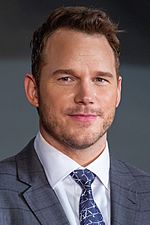
Chris Pratt voices Mario in the 2023 film. The movie shows Mario and Luigi as Italian-American plumbers. They start their own business in Brooklyn after working for a boss named Foreman Spike.
Mario's Popularity and Impact
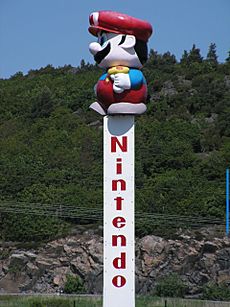
As Nintendo's mascot, Mario is known as the most famous video game character ever. He is an icon of the gaming world. The Mario video game series has sold over 510 million copies. This makes it the best-selling video game franchise. Mario was one of the first video game characters to be honored at the Walk of Game in 2005. He was inducted alongside Link and Sonic the Hedgehog. In 2003, Mario was the first video game character to get a wax figure at the Hollywood Wax Museum. In 1990, a survey found that American children recognized Mario more than Mickey Mouse. Mario has also been called the "most recognizable" figure in the gaming industry.
Creator Shigeru Miyamoto has said Mario is his favorite character he ever created. Electronic Gaming Monthly gave Mario their "Coolest Mascot" award in 1996. They called him "an age-old friend." Nintendo Power listed Mario as their favorite hero. They mentioned his mustache, red cap, plumbing skills, and mushrooms as his key features. In a 2008 poll in Japan, Mario was voted the most popular video game character.
GameDaily listed Mario as an "unlikely hero" on its top 25 video game archetypes. They said he kept going even though he should have run out of energy. Mario ranked fourth on GameDaily's top ten Smash Bros. characters list. Mario was fourth on UGO's list of the "Top 100 Heroes of All Time." They also listed Mario's hat twenty-first on their list of "The Coolest Helmets and Headgear in Video Games." Empire ranked him as the second-greatest video game character. CNET listed him first on its list of the "Top 5 video game characters."
Mario was even voted 100th in IGN's Top 100 Villains for his role in Donkey Kong Junior. They said, "This Mario is a total jerk, holding Donkey Kong Jr.'s dad hostage." GamesRadar also named him the 90th "most dastardly ne'er-do-wells" villain in video games.
Mario's Lasting Impact
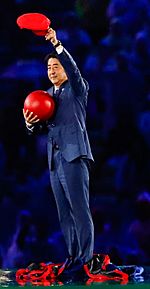
Mario has become a pop culture icon. He has appeared on lunch boxes, T-shirts, magazines, and commercials. You can find him on candy, shampoo bottles, cereal, badges, board games, and as plush toys.
Mario has inspired many unofficial creations. These include paintings, performances on shows like India's Got Talent, and short films. These have been watched hundreds of thousands of times. The character has appeared in works by other companies. For example, in the iOS and Android game Platform Panic, one of the purchasable skins is a reference to him.
Many people and places have been named after Mario. Bergsala, Nintendo's distributor in the Nordic and Baltic countries, is on Marios Gata 21 (Mario's Street 21) in Kungsbacka, Sweden. Many sports stars have been nicknamed "Super Mario." These include Bundesliga football players Mario Götze and Mario Gómez, National Hockey League player Mario Lemieux, and Italian cyclist Mario Cipollini. In a suburb of Zaragoza, Spain, streets were named after video games, including "Avenida de Super Mario Bros."
Mario's legacy is recognized by Guinness World Records. They gave the Nintendo mascot and his platform game series seven world records in the Guinness World Records: Gamer's Edition 2008. These include "Best Selling Video Game Series of All Time" and "Most Prolific Video Game Character." Mario has appeared in 116 original games. In 2009, Guinness World Records listed him as the second most recognizable video game character in the United States. He was recognized by 93% of people, just behind Pac-Man (94%). In 2011, readers of Guinness World Records Gamer's Edition voted Mario as the top video game character of all time.
Mario appeared in the 2016 Summer Olympics closing ceremony. This was to promote the 2020 Summer Olympics in Tokyo. In a video, Japanese prime minister Shinzō Abe dressed as Mario. He used a Warp pipe from Shibuya Crossing to Maracanã Stadium. Abe then appeared dressed as Mario in a giant Warp Pipe in the middle of the stadium.
Mario Day is celebrated on March 10. This is because when the date is written as Mar 10, it looks like "Mario." Nintendo has officially celebrated this day since 2016. They promote Mario games and hold Mario-related events every year.
Images for kids
-
The character was named after Mario Segale, a real estate developer.
See also
 In Spanish: Mario (personaje) para niños
In Spanish: Mario (personaje) para niños


